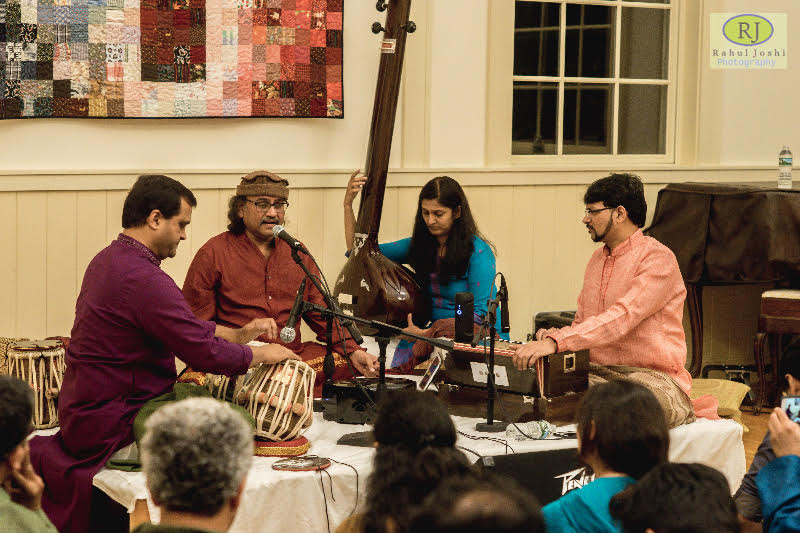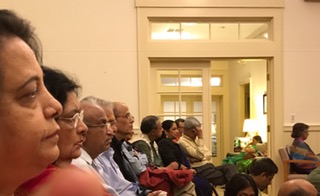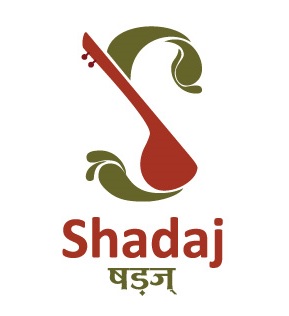Contribute
| Memorable Hindustani Classical Vocal Concert By Pandit Raghunandan Panshikar |
Shuchita Rao
09/28/2016
Pandit Raghunandan Panshikar, a senior disciple of Padma-Vibhushan Gaan Saraswati Smt. Kishori Amonkar presented a Hindustani classical vocal music on Saturday, September 24 at the Pilgrim Church in Lexington, MA. The concert was organized by local non-profit organization Shadaj which has organized several other successful classical music concerts featuring renowned practitioners of classical music such as vocalists Vidushi Smt. Arati Ankalikar-Tikekar, Pandit Jayteerth Mevundi, Pandit Bhuvanesh Komkali, Ustad Arshad Ali and sitar maestro Ustad Shahid Parvez.
On a night before the performance (Friday, Sep 23), an informal conversation with the artists took place at the residence of Shri Rajesh Godbole, founder of Shadaj organization. Historical aspects relating to the birth of Jaipur gharana and the contribution of Gaan Saraswati Smt. Kishori Amonkar to Jaipur gharaana were discussed. Legend has it that the founder of Jaipur Gharana, Ustad Alladiya Khan had problems with his voice due to over-exertion of vocal chords when he worked as the appointed court musician in the Rajput province of Amleta. To accommodate his handicap, the Ustad developed a specialized style of singing khayaals with extensive use of aakaar (aa sound), faster tempo compositions than the prevalent slow Dhrupad-Dhamar compositions and using intricate taan patterns while delineating ragas through khayaals. This unique style of presentation came to be known as Jaipur Gharana gaayaki and Ustad Alladiya Khan gained recognition as the high priest of Khayal gaayaki.
Ustad Alladiya Khan taught Vidushi Mogubai Kurdikar, who then trained her daughter, Gaan Saraswati Kishori Amonkar and other disciples including Pandit Panshikar. While Pandit Panshikar’s formal study of Hindustani vocal music had started at the age of eleven under the renowned Mumbai based vocalist, the late Pandit Vasantrao Kulkarni, he learned music from Gaan Saraswati Smt. Kishori Amonkar for over 17 years.
In the first half of the program on September 24, Pandit Panshikar presented two compositions in the popular night melody, Raga Yaman. The first khyaal was “Mo munuh lagan laagi†set to teentaal, a rhythmic cycle of 16 beats in madhyalaya (middle tempo) while the next composition was a popular khayal that has stood the test of time over several generations - “Aeri aali piya bina†set again to a rhythmic cycle of 16 beats but in drut laya (fast tempo). In a detailed exposition of Yaman in the vilambit portion of the presentation, Pandit Panshikar wove myriad, novel patterns with the Yaman notes and kept the audience’s attention for over an hour. Like a skilled architect who was at complete ease with the craft of creating a powerful musical atmosphere, Pandit Panshikar’s resonant voice with its trills, shakes, alternation between straight and oblique treatment of notes and rich imagination reminded the listeners of the maturity and brilliance of the gaayaki of his Guru, Vidushi Smt. Kishori Amonkar. It seemed
like Pandit Panshikar had not only internalized the essential character of Yaman raga but also the approach of his Guru to constructing the raga from scratch to a grand structure endowed with beauty and elegance.
A ragamaala that navigated 16 ragas such as Hindol, Bhoopali, Chaayanat, Bilaawal, Shankara, Des, Tilak-kamod, Basant, Shree, Marwa, Bhairav, Pooriya, Bhairavi, Jaunpuri, Madhmaad Saarang and Maalkauns was the next offering. With each raga, Pandit Panshikar managed to paint the appropriate colors to create the mood of the individual ragas. His ability to sing taans (fast melodic sequences) with heavy gamak (oscillations) while expanding on some of the ragas in the raagmaala was particularly impressive.
In the second half of the program, khayaals in ragas popular with musicians of Jaipur gharaana were performed. A composition “Devo Satsang†in raga Saawani Kalyan set to a rhythmic cycle consisting of 10 beats, jhaptaal, progressed systematically with musical phrases including a new note in the ascent with each alaap (slow melodic movement). A zig-zag vakra movement in the descent, the technique of constructing musical patterns aligned with rhythm (laya based gaayaki), the method of adding a new word from the lyrics at the end of each alaap and the emotional approach to the top Sa note made the rendition engaging. In the faster paced composition created by Smt. Mogubai Kurdikar , “Jaya Jagata Jananiâ€, taan patterns emerged like fireworks, sometimes aligned evenly to the rhythmic tempo and at other times racing faster than the accompanying tempo.
In Raga Sampoorna Malkauns, another composition by Smt. Mogubai Kurdikar, Banwaari Shyaam Moray, set to 16 beat cycle teental was rendered. In a departure from traditional Jaipur gharaana gaayaki which is known for its extensive use of aakaar in the raga development, Pandit Panshikar used the lyrics of the composition, Banwaari shyaam in a pleasing manner. “The raga has 5 notes of Malkauns in ascent but all the 7 notes in descent and that is why it is known as Sampoorna Malkaunsâ€, he explained to the members of the audience.
A composition by Smt. Kishori Amonkar “â€Ja re ja re papiha piya ghur†in the raga Bhoop Nat set to addhaa, a 16 beat rhythmic cycle was the next offering. The “Kalyan†ang of Bhoopali as well as the “Nat†ang were balanced beautifully in the presentation.
In the last offering of the evening, a devotional abhang “Padmanabha Narayanaâ€, Pandit Panshikar’s crisp diction and fluid delivery transported the listeners in attendance to a state of joy and ecstacy. Shri Bharat Kamat, a veteran tabla player known for his signature accompaniment for vocalists, Shri Niranjan Lele on the harmonium, (disciple of the renowned Pandit Tulsidas Borkar) provided excellent accompaniment with great style and sensitivity. Ms. Ashwini Paranjape on taanpura and tabla artist Shri Rajesh Pai on the manjeera were the local artists who provided great support to the team. Pandit Panshikar was a secure and mature performer who encouraged his supporting artists by giving them opportunities to showcase their artistic mettle independently.
The music of the pleasant and humble artist, Pandit Panshikar was received very well by Boston based classical music loving audience. Jyoti Joshi, known for her skill as an artist could be seen sitting in the audience, sketching while listening to the music. “The beautiful music made me pick up my pen to draw and sketch after a hiatus of several years†said Jyoti. Kudos to the Shadaj team of volunteers for a wonderful job.
You may also access this article through our web-site http://www.lokvani.com/

.jpg)

